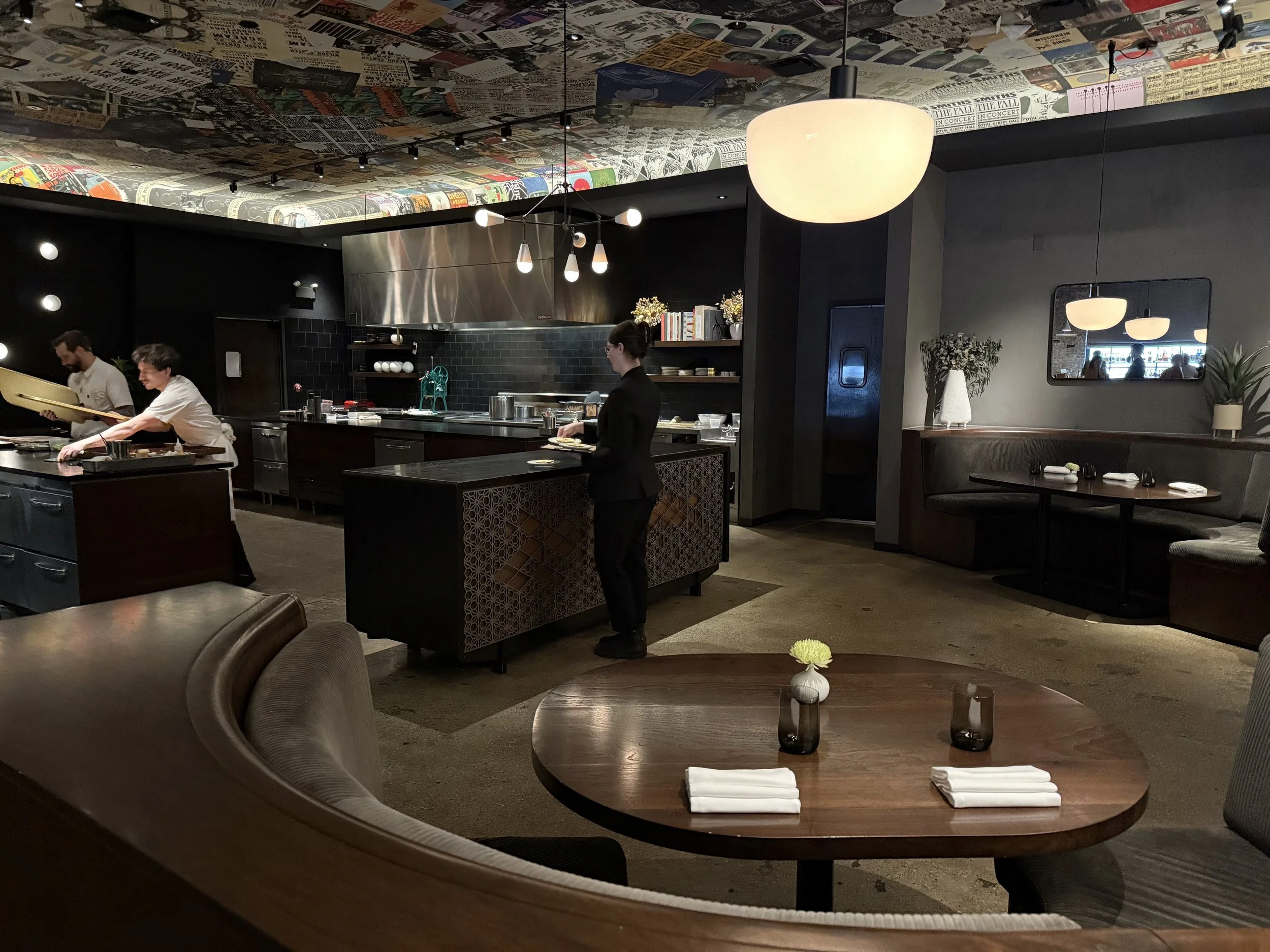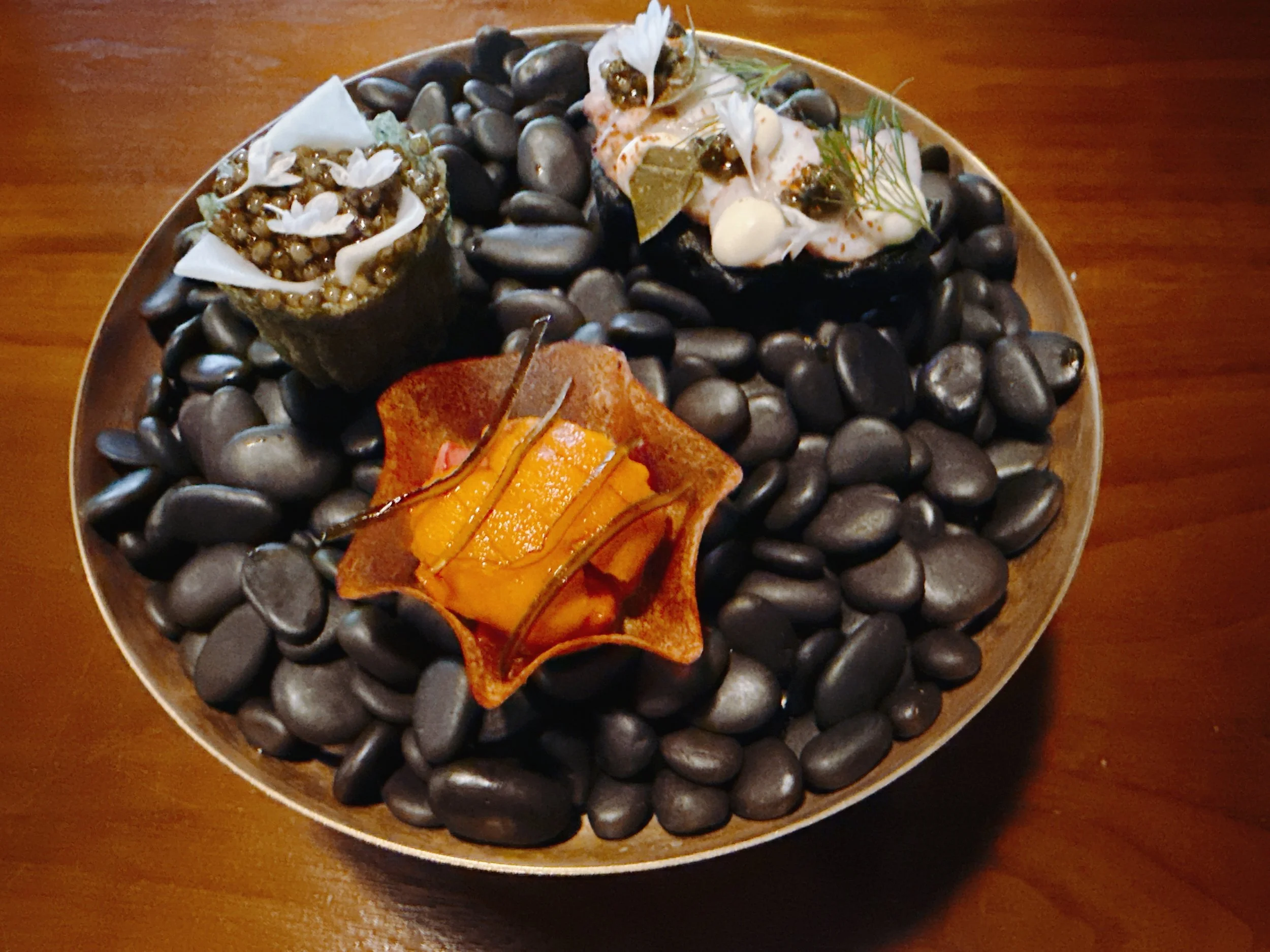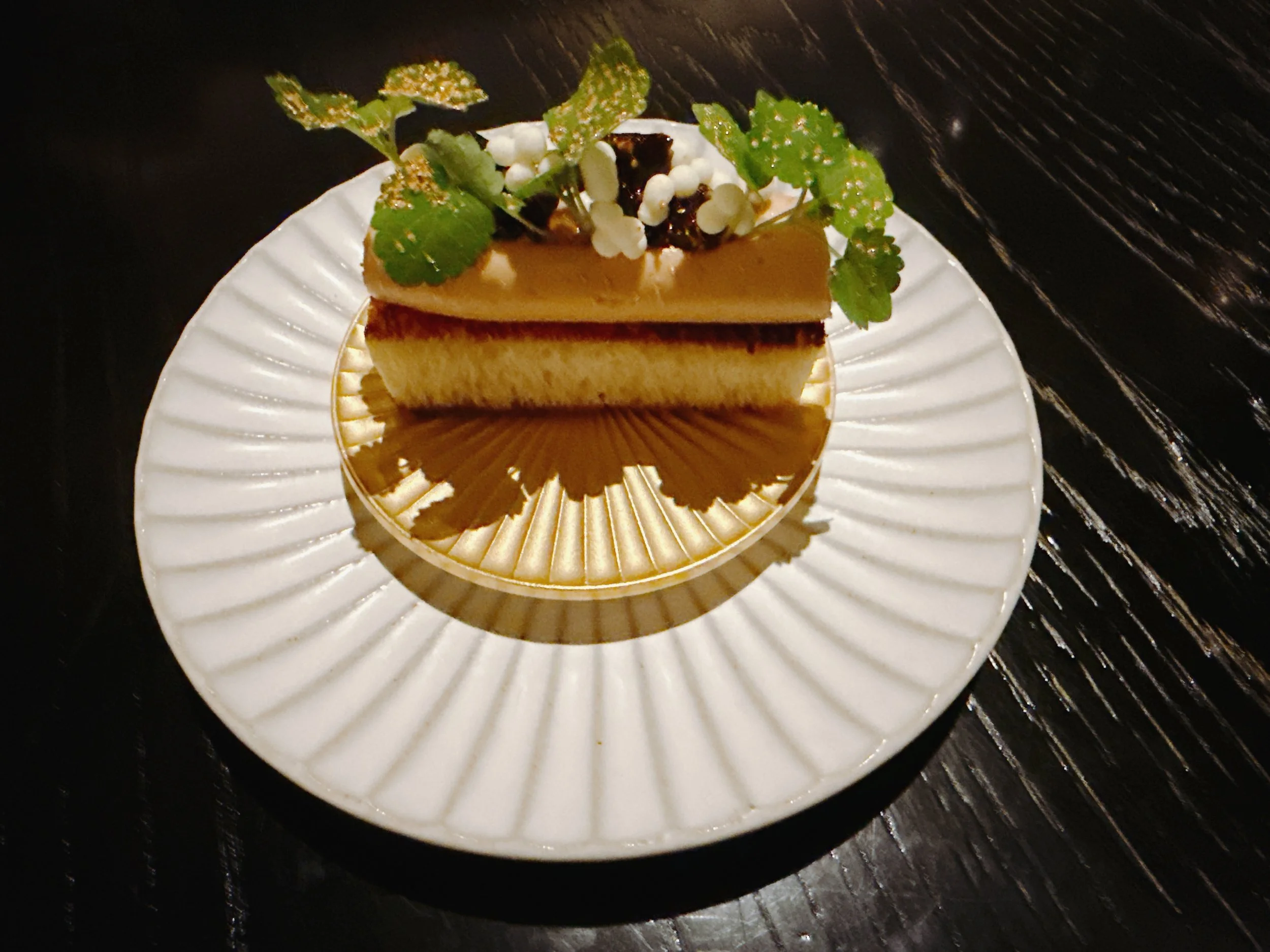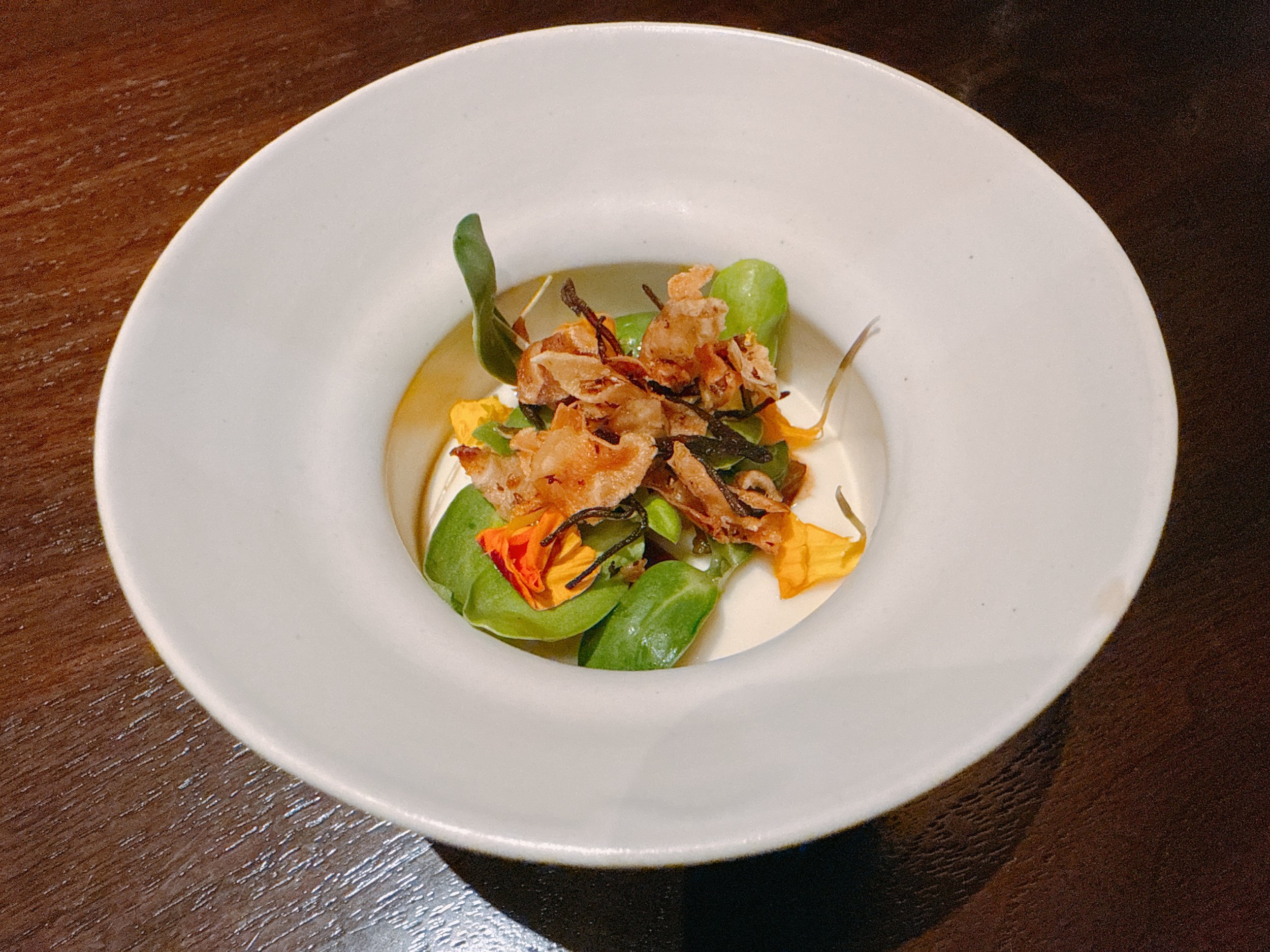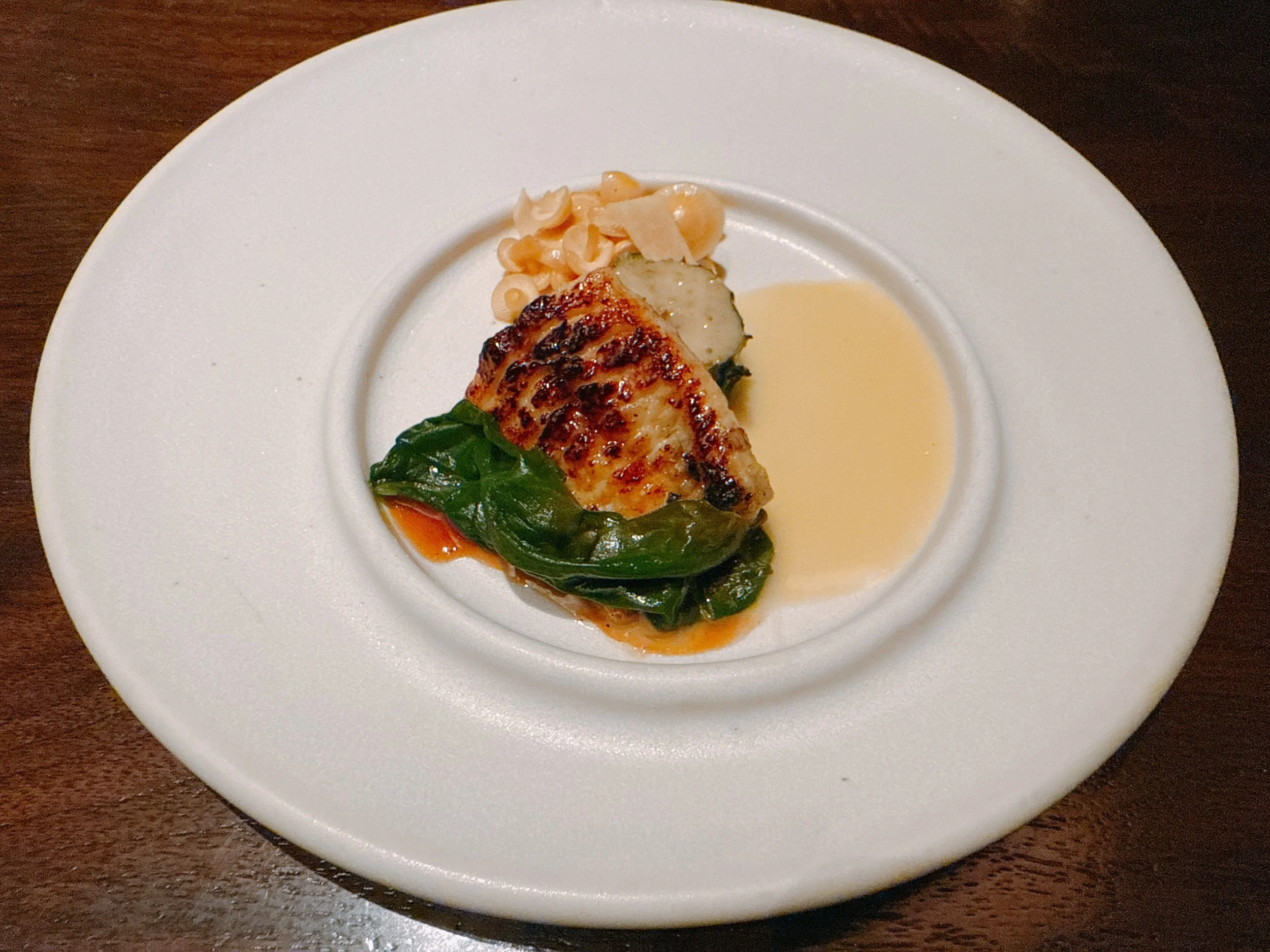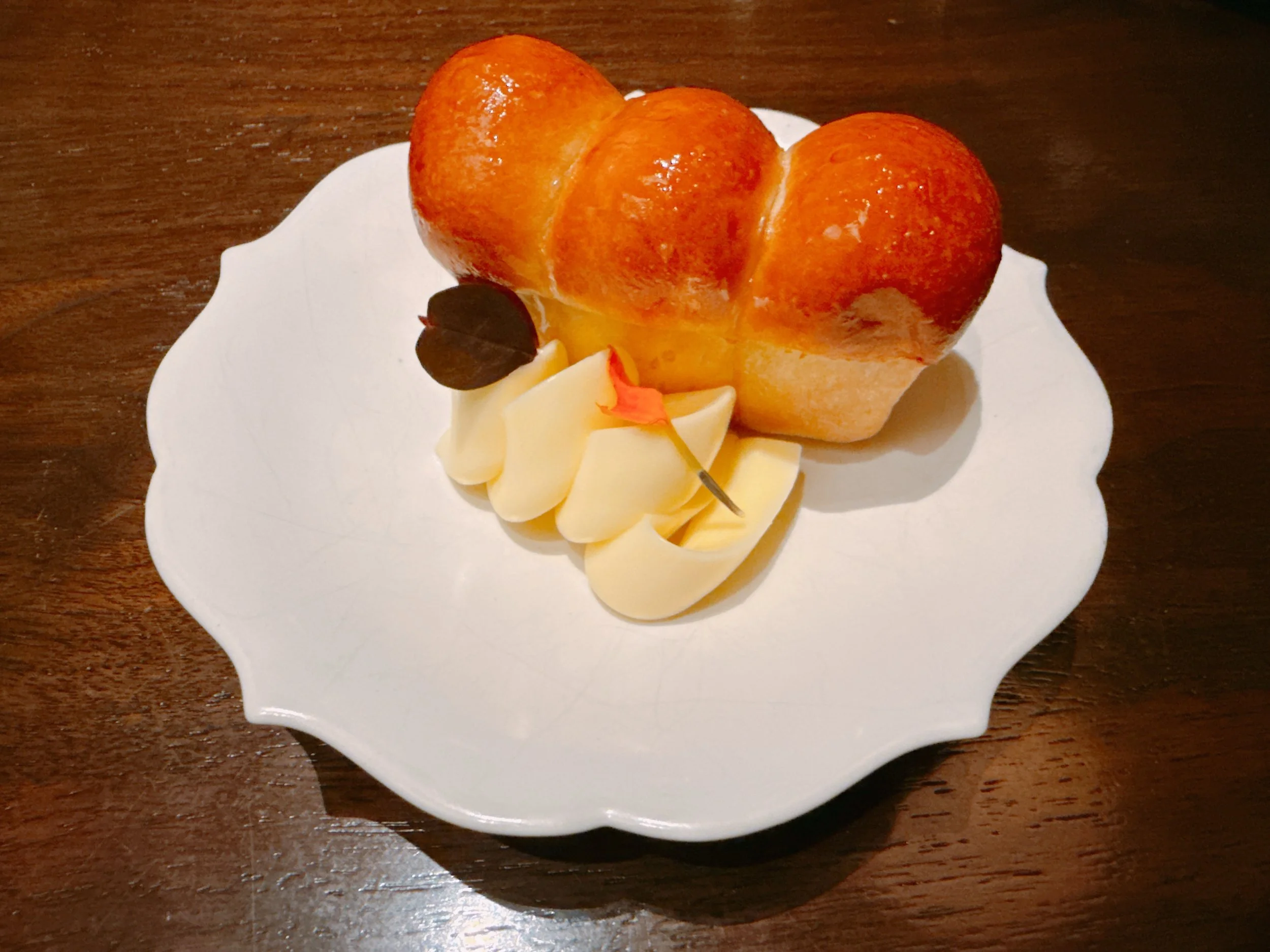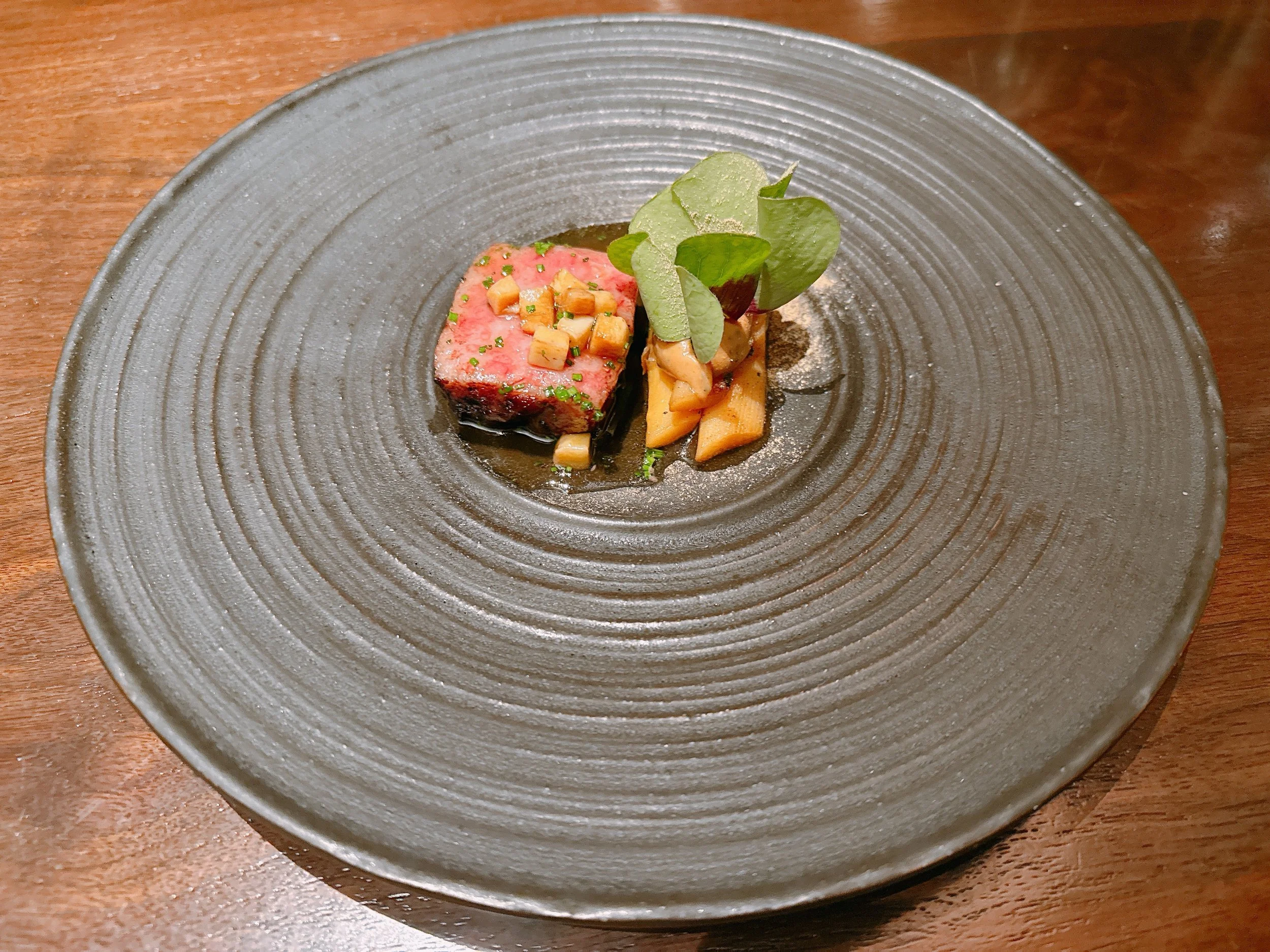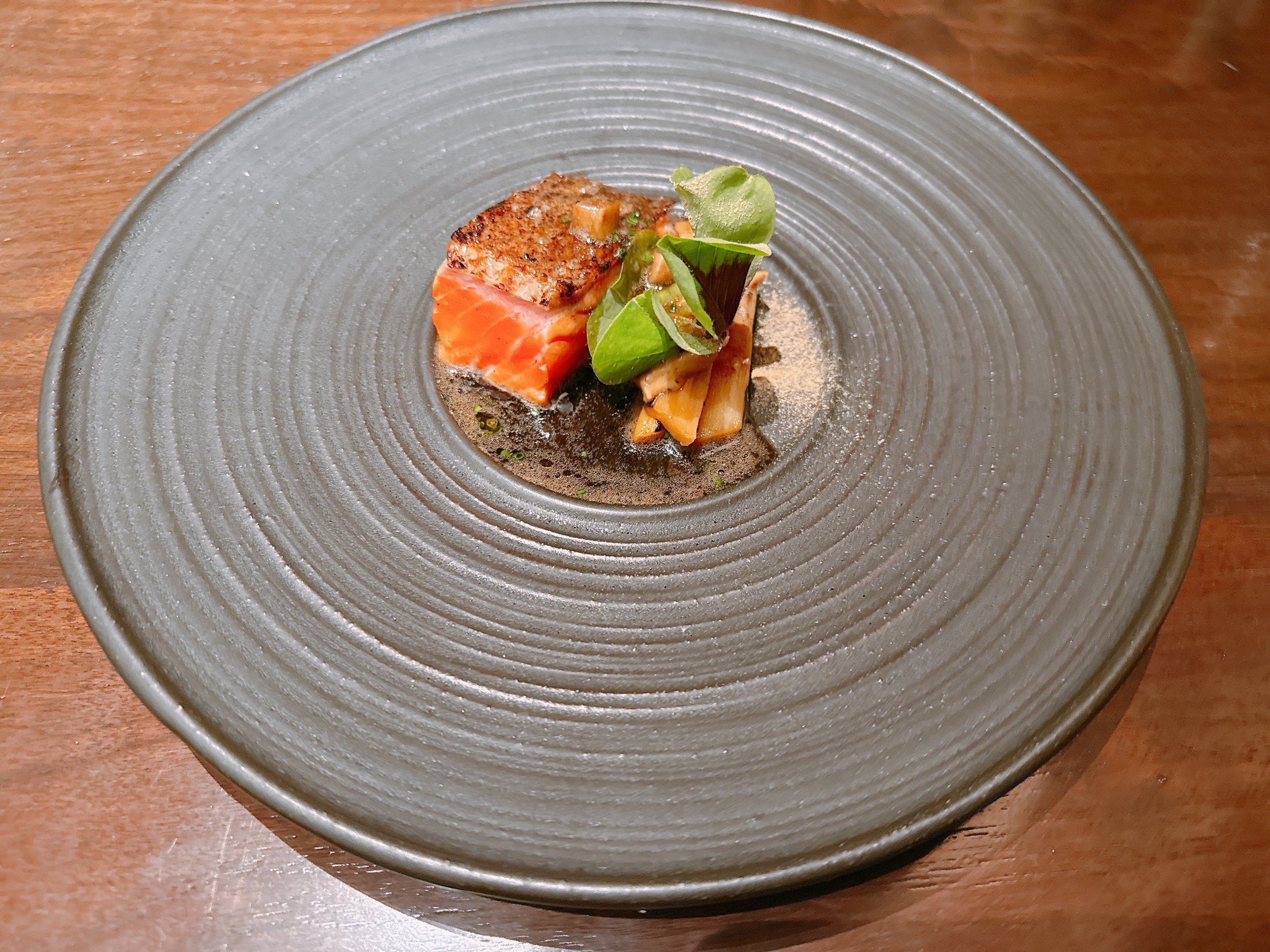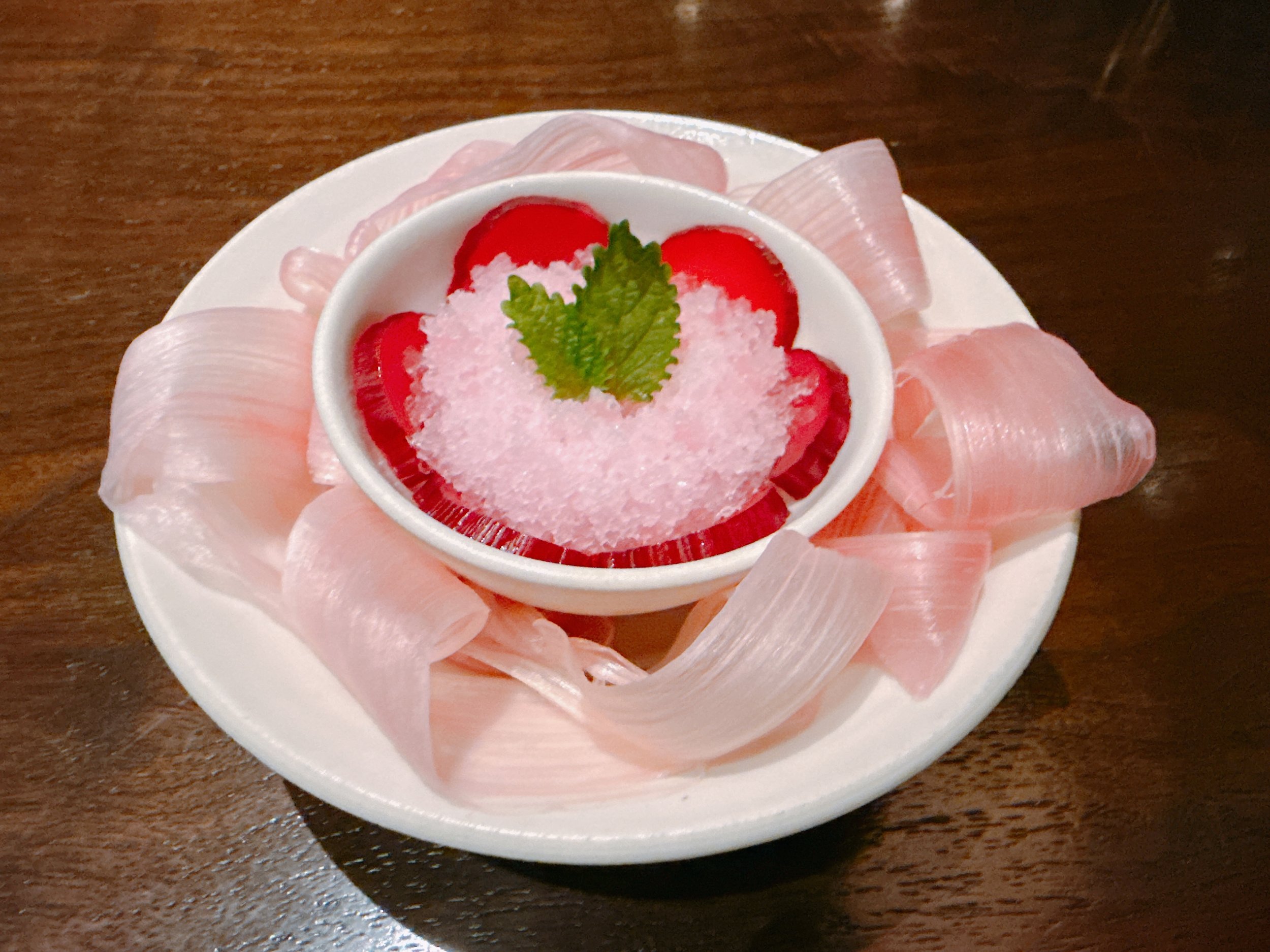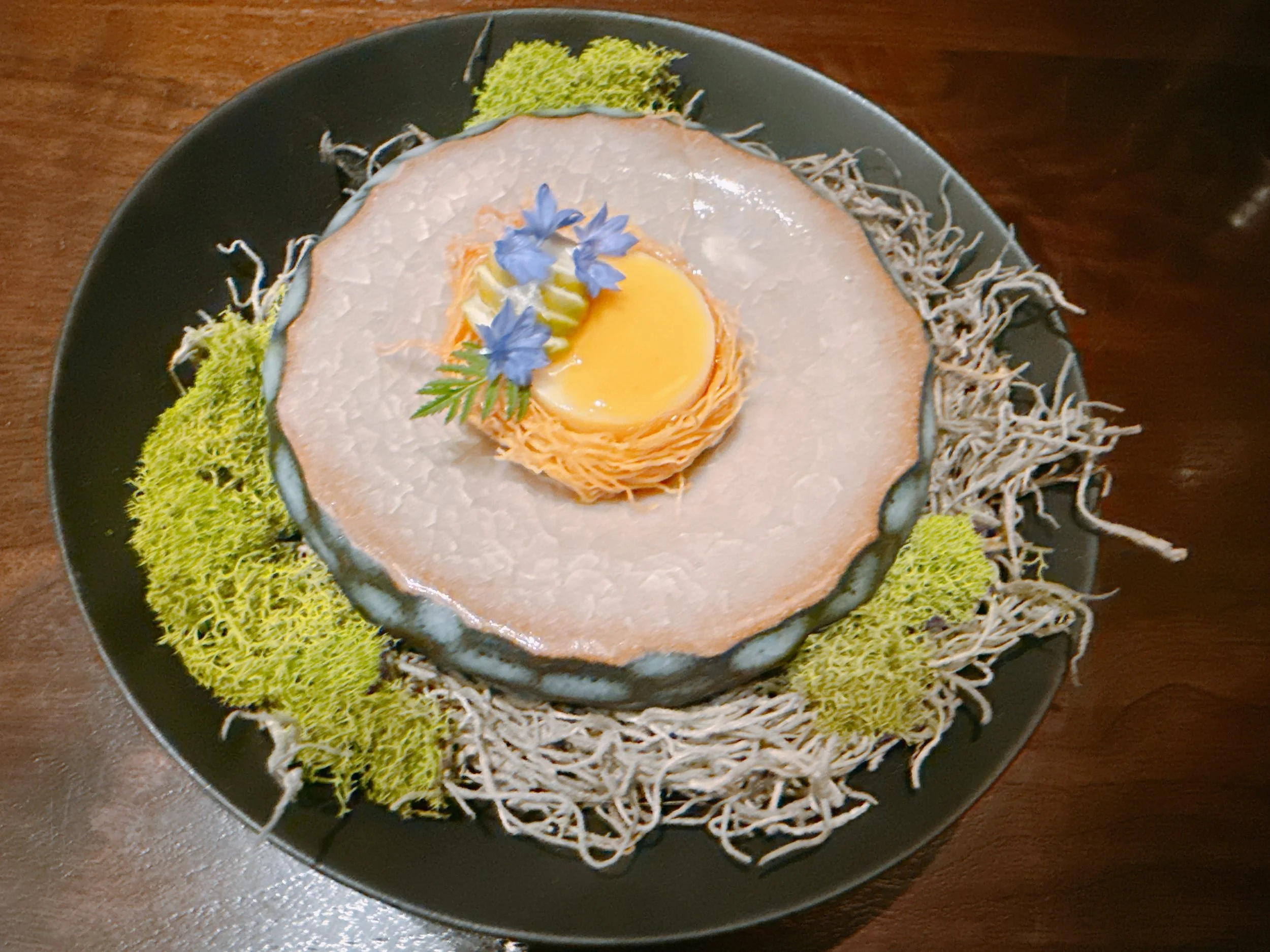Oriole - Chicago
Rating: 16/20
Where: Chicago, IL
When: Dinner for 3 on 10 April 2025
Cost per Person: Tasting menu $325, Wine pairing $195-$350
Accolades: 2 Michelin Stars
Why: Relaxed modern setting; different preparations of the same ingredient
Entering Chicago's two-Michelin-starred “Oriole” is a little adventure. From the outside, there is barely any signage, there are no visible windows - only a gray door. After checking in at the host stand inside, we stepped into a freight elevator. But, for better or worse, the restaurant was also on the ground floor, and the elevator never moved, and simply opened on the other side. This led us to a huge open industrial space, mostly painted in black. The open kitchen's ceiling was plastered with posters for musical performances.
Our dinner started at a bar counter. Reservations were staggered, so that at most six people began their dinner at the same time - that was the number of available seats at the bar. Since the tasting menu was fixed, there were no food choices to be made (dietary restrictions were accommodated with prior notice). Drinks-wise, we could pick among three pairings: one non-alcoholic pairing ($125), and two wine pairings ($195 and $350), the latter including two glasses of sake. I tried the more expensive wine pairing, and the wines were uniformly pretty good, and frequently from relatively expensive bottles, retailing at several hundred dollars. The pours were on the modest side, though - this was not the kind of pairing that one could reasonably split among two people. While the pairing started only with the third course, one didn't have to order an aperitif, since the first two courses arrived with complimentary beverage accompaniments (a sparkling sake and a vermouth) - a nice touch that I wish was done by more restaurants.
Our first course was served right at the bar and consisted of three bites, all incorporating golden kaluga caviar. We began with a rhubarb tart that was filled with yuzu aioli and Hokkaido uni (sea urchin). Biting into this, one initially got hints of sweetness from the rhubarb tart, before moving on to flavors of uni. There was a texture similar to an oyster, and a seafoody taste overall 17. A sea lettuce tart was filled with kohlrabi and an eel from Maine. The filling was acidic, feeling somewhat marinated. Together with the crunchy veggies and the chopped eel, this dish felt almost Scandinavian 17. Finally, a black cracker shell made from activated charcoal was filled with Spanish octopus carpaccio, crème fraîche, capers and dill. The octopus was a bit chewy, and the light sauce had a slight dill flavor 16.
After this first course, we were led to a counter right in front of the open kitchen. This table might have been used as the pass if it wasn't continuously used for serving every guest’s second course. This dish was a sugar-glazed brioche topped with a foie gras mousse, mission figs cooked in vermouth (the same spirit that was paired with the dish) and some crème fraîche dipping dots on top. The brioche with its crunchy glaze was quite nice, the toppings sweet and creamy. Overall, this felt a bit like a jelly sandwich 17. The pescatarian alternative used tofu instead of foie gras. Its texture was a bit less creamy, making the result a bit too sweet 16.
After that, we finally arrived at our table. In our case, we sat at one of the two tables with a direct view of the kitchen, but there was also a regular dining room a few steps away. The following course was accompanied by the first glass of the wine pairing. It consisted of three preparations of dungeness crab. First, a croquette filled with crab meat and topped with an espelette pepper aioli. Tasting bready and fried, this bite didn't have much crab flavor 14. Next was a tapioca chip topped with crab tartare and a horseradish aioli. The chip was a bit soft, but the aioli along with some crunchy cucumbers made for a fresh bite. Strangely, again not much crab flavor 16. Finally, we received some crab meat paired with cucumbers, nasturtium leaves and a broth made of cucumbers, wild onions and lemons. The crab flavor was more noticeable here, and felt quite fresh. However, the other flavors in the dish were even stronger: sweet cucumbers and herbs 15.
The following dish was a potato espuma served with sunchokes, sake lees, lemongrass, Chinese artichokes, some herbs, marigold, and sunchoke chips, all seasoned with shio kombu. The foam had a good consistency, but was a bit sweet, as were the Chinese artichokes, making for dish that felt too sweet overall. The chips added some nice crunch, though 15.
More eel from Maine arrived in the following dish. This time, it was served two ways: as a bbq'ed filet with green garlic and as a torchon with spring onions. Also on the plate: enoki mushroom caps, Swiss chard, and a beurre blanc infused with mushrooms. The filet was quite nice, savory and with a solid bite. The minced eel was not quite as compelling, but still decent, with a more fishy taste. The beurre blanc was a bit thin by itself, the enoki mushrooms pretty flavorless, but decent combined with the ginger that was mixed among them 16.
Capellini pasta had been made with 10% caraway seeds, and was dressed with Parmesan, a lemon sauce and shaved black truffles. On the side was a shokupan and a koji fermented butter. The bread and butter were a bit plain, but maybe that was intentional, so one could sop up the rest of the sauce (14 maybe). The pasta had a distinct caraway seed taste, reminiscent of a rye bread. A creamy, slightly truffly dish. Overall fine, but not as compelling as one might expect from a “signature dish” 16.
The final savory course was a filet of A5 wagyu beef. It had been seasoned with fermented cherries, black garlic and mushrooms, before being finished on the binchotan grill. On the side was some white asparagus, a veal jus and mushrooms. The meat was nicely marbled, fatty and flavorful, the asparagus was a bit stringy, sweet and crunchy. Overall a pretty heavy dish 17. The pescatarian replacement for this dish was a trout that was very flavorful and nicely prepared - it looked barely cooked inside 17.
A pre-dessert of sorts was based on three different preparations of rhubarb. These sets of threes were apparently a theme in this menu, but this time done they appeared in a single dish and not as separate ones. We got a rhubarb sorbet made with pickled ginger, a rhubarb granita with lemongrass and some candied rhubarb, all topped with a few leaves of lemon balm. The granita was very light, the sorbet had a nice flavor and the candied rhubarb was marinated and acidic. Lots of different flavors associated with rhubarb then: sweet, acidic and fruity 16.
Our main dessert had strands of filo dough surrounding a goat cheese/lavender semifreddo that was topped with green almonds and a honey/ice wine vinegar sauce. Thanks to that sauce, the dish had a sweet honey taste with an aftertaste of lavender. The filo dough added some nice crunch. Only the tart green almonds were a bit of an outlier from a flavor perspective 16.
Four petit fours concluded our dinner. A basil/strawberry ganache macaroon provided a nice flavor combination and wasn't too sweet 17. A pain perdu was topped with mushrooms, quince jam and cheese. Not really sweet - this was quite a savory dish thanks to the cheese 15. An apricot/tamarind/tapioca pate de fruit was fruity, but more acidic than sweet 16. Finally, a dark chocolate coconut truffle had a slightly crumbly filling. Ok, but not great 14.
Overall: A nice dinner with great, relaxed service. Starting the experience at multiple stations was an especially nice touch. There was a mini-theme of the same ingredient being prepared different ways in a single course, but otherwise, there didn't seem to be an overarching “story” behind the meal 16.
